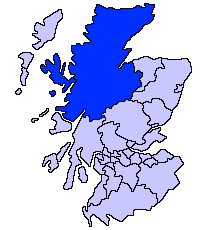 |
| Highland council area Shown as one of the council areas of Scotland |
| 1995 to 1999 wards |
| 1999 to 2007 wards |
| 2007 to 2017 wards |
| 2017 wards |
The second set of Highland Council wards of Scotland, 80 in number, became effective for election purposes in 1999, for the second general election of the Highland Council, [1] and were used also for the third general election in 2003. These wards replaced 72 older wards, and were themselves replaced by a set of 22 wards for the fourth general election in 2007.
Contents
- Lists of wards, 1999 to 2007
- Badenoch and Strathspey wards
- Caithness wards
- Inverness wards
- Lochaber wards
- Nairn wards
- Ross and Cromarty wards
- Skye and Lochalsh wards
- Sutherland wards
- See also
- Notes and references
The Highland Council (Comhairle na Gaidhealtachd in Gaelic) had become a local government authority in 1996, when the two-tier system of regions and districts was abolished and the Highland region became a unitary council area, under the Local Government etc. (Scotland) Act 1994. The first Highland Council election, however, was one year earlier, in 1995. Until 1996 councillors shadowed the regional and district councils and planned for the transfer of powers and responsibilities. Elections to the council are normally on a four-year cycle, all wards being contestable at each election.
For the periods 1995 to 1999 and 1999 to 2007, each ward elected one councillor by the first past the post system. In 2007, this arrangement was replaced with one of multi-member wards, each electing three or four councillors by the single transferable vote system, to produce a form of proportional representation.
The wards used from 1995 to 1999 had been subdivisions of eight council management areas, with councillors elected from each area forming an area committee. The wards created in 1999, however, were not exactly subdivisions of the management areas, management area boundaries were not adjusted to take account of new ward boundaries and, therefore, area committees ceased to be exactly representative of areas for which they were named and for which they took decisions.
In 2007, the management areas were replaced with three new corporate management areas, each consisting of a whole number of the new multi-member wards.